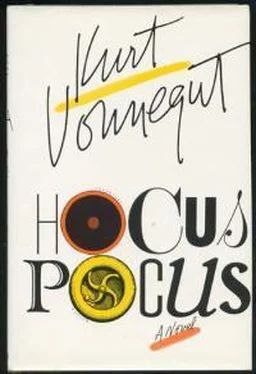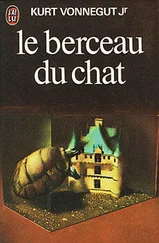Kurt Vonnegut - Hocus Pocus
Здесь есть возможность читать онлайн «Kurt Vonnegut - Hocus Pocus» весь текст электронной книги совершенно бесплатно (целиком полную версию без сокращений). В некоторых случаях можно слушать аудио, скачать через торрент в формате fb2 и присутствует краткое содержание. Жанр: Современная проза, на английском языке. Описание произведения, (предисловие) а так же отзывы посетителей доступны на портале библиотеки ЛибКат.
- Название:Hocus Pocus
- Автор:
- Жанр:
- Год:неизвестен
- ISBN:нет данных
- Рейтинг книги:4 / 5. Голосов: 1
-
Избранное:Добавить в избранное
- Отзывы:
-
Ваша оценка:
- 80
- 1
- 2
- 3
- 4
- 5
Hocus Pocus: краткое содержание, описание и аннотация
Предлагаем к чтению аннотацию, описание, краткое содержание или предисловие (зависит от того, что написал сам автор книги «Hocus Pocus»). Если вы не нашли необходимую информацию о книге — напишите в комментариях, мы постараемся отыскать её.
Hocus Pocus — читать онлайн бесплатно полную книгу (весь текст) целиком
Ниже представлен текст книги, разбитый по страницам. Система сохранения места последней прочитанной страницы, позволяет с удобством читать онлайн бесплатно книгу «Hocus Pocus», без необходимости каждый раз заново искать на чём Вы остановились. Поставьте закладку, и сможете в любой момент перейти на страницу, на которой закончили чтение.
Интервал:
Закладка:
“Maybe I should go looking for it,” she said.
“I’m sure somebody else found it, and just isn’t saying anything,” I said.
“I never asked you to pay for anything before,” she said. “How about you buy me a new transmission? Then, when anybody asks me, ‘Where did you get that beautiful transmission?’ I can answer, ‘An old lover gave that to me. He is a very famous war hero, but I am not free to reveal his name.’”
“Who is the mechanic?” I asked.
“The Prince of Wales,” she said. “If I go to bed with him, he will not only fix my transmission, he will make me the Queen of England. You never made me Queen of England.”
“Was it Whitey VanArsdale?” I said. This was a mechanic down in town who used to tell everybody that he or she had a broken transmission. He did it to me with the car I had before the Mercedes, which was a 1979 Chevy station wagon. I got a second opinion, from a student, actually. The transmission was fine. All I’d wanted in the first place was a grease job. Whitey VanArsdale, too, is now buried next to the stable. He ambushed some convicts and got ambushed right back. His victory lasted 10 minutes, if that. It was, “Bang,” and then, a few minutes later, “Bang, bang,” right back.
Pamela, sitting on the ground with her back to the tombstone, didn’t do to me what Zuzu Johnson would soon do to me, which was to identify me as a major cause of her unhappiness. The closest Pam came to doing that, I guess, was when she said I had never made her the Queen of England. Zuzu’s complaint would be that I had never seriously intended to make her my wife, despite all our talk in bed about our running off to Venice, which neither one of us had ever seen. She would open a flower shop there, I promised her, since she was so good at gardening. I would teach English as a second language or help local glassblowers get their wares into American department stores, and so on.
Zuzu was also a pretty good photographer, so I said she would soon be hanging around where the gondolas took on passengers, and selling tourists Polaroid pictures of themselves in gondolas right then and there.
When it came to dreaming up a future for ourselves, we left GRIOT™ in the dust.
I considered those dreams of Venice part of lovemaking, my erotic analogue to Zuzu’s perfume. But Zuzu took them seriously. She was all set to go. And I couldn’t go because of my family responsibilities.
Pamela knew about my love affair with Zuzu, and all the hocus pocus about Venice. Zuzu told her.
“You know what you ought to say to any woman dumb enough to fall in love with you?” she asked me. Her gaze was on Musket Mountain, not on me.
“No,” I said.
And she said, “‘Welcome to Vietnam.’”
She was sitting over the Shultzes in their caskets. I was standing over a severed head which would be dug up by a backhoe in 8 years. The head had been in the ground so long that it was just a skull.
A specialist in Forensic Medicine from the State Police happened to be down here when the skull showed up in the backhoe’s scoop, so he had a look at it, told us what he thought. He didn’t think it was an Indian, which was my first guess. He said it had belonged to a white woman maybe 20 years old. She hadn’t been bludgeoned or shot in the head, so he would have to see the rest of the skeleton before theorizing about what might have killed her.
But the backhoe never brought up another bone.
Decapitation, alone, of course, could have done the job.
He wasn’t much interested. He judged from the patina on the skull that its owner had died long before we were born. He was here to examine the bodies of people who had been killed after the prison break, and to make educated guesses about how they had died, by gunshot or whatever.
He was especially fascinated by Tex Johnson’s body. He had seen almost everything in his line of work, he told me, but never a man who had been crucified, with spikes through the palms and feet and all.
I wanted him to talk more about the skull, but he changed the subject right back to crucifixion. He sure knew a lot about it.
He told me one thing I’d never realized: that the Jews, not just the Romans, also crucified their idea of criminals from time to time. Live and learn!
How come I’d never heard that?
Darius, King of Persia, he told me, crucified 3,000 people he thought were enemies in Babylon. After the Romans put down the slave revolt led by Spartacus, he said, they crucified 6,000 of the rebels on either side of the Appian Way!
He said that the crucifixion of Tex Johnson was unconventional in several ways besides Tex’s being dead or nearly dead when they spiked him to timbers in the stable loft. He hadn’t been whipped. There hadn’t been a cross-beam for him to carry to his place of execution. There was no sign over his head saying what his crime was. And there was no spike in the upright, whose head would abrade his crotch and hindquarters as he turned this way and that in efforts to become more comfortable.
As I said at the beginning of this book, if I had been a professional soldier back then, I probably would have crucified people without thinking much about it, if ordered to do so.
Or I would have ordered underlings to do it, and told them how to do it, if I had been a high-ranking officer.
I might have taught recruits who had never had anything to do with crucifixions, who maybe had never even seen one before, a new word from the vocabulary of military science of that time. The word was crurifragium. I myself learned it from the Medical Examiner, and I found it so interesting that I went and got a pencil and wrote it down.
It is a Latin word for “breaking the legs of a crucified person with an iron rod in order to shorten his time of suffering.” But that still didn’t make crucifixion a country club.
What kind of an animal would do such a thing? The old me, I think.
The late unicyclist Professor Damon Stern asked me one time if I thought there would be a market for religious figures of Christ riding a unicycle instead of spiked to a cross. It was just a joke. He didn’t want an answer, and I didn’t give him one. Some other subject must have come up right away.
But I would tell him now, if he hadn’t been killed while trying to save the horses, that the most important message of a crucifix, to me anyway, was how unspeakably cruel supposedly sane human beings can be when under orders from a superior authority.
But listen to this: While idly winnowing through old local newspapers here, I think I have discovered whom that probably Caucasian, surely young and female skull belonged to. I want to rush out into the prison yard, formerly the Quadrangle, shouting “Eureka! Eureka!”
My educated guess is that the skull belonged to Letitia Smiley, a reputedly beautiful, dyslexic Tarkington senior who disappeared from the campus in 1922, after winning the traditional Women’s Barefoot Race from the bell tower to the President’s House and back again. Letitia Smiley was crowned Lilac Queen as her prize, and she burst into tears for reasons nobody could understand. Something obviously was bothering her. People were agreed, I learn from a newspaper of the time, that Letitia Smiley’s tears were not happy tears.
One suspicion had to be, although nobody said so for publication, that Miss Smiley was pregnant—possibly by a member of the student body or faculty. I am playing detective now, with nothing but a skull and old newspapers to go on. But at least I have what the police were unable to find back then: what might be proof positive in the hands of a forensic cranial expert that Letitia Smiley was no longer among the living. The morning after she was crowned Lilac Queen, her bed was found to contain a dummy made of rolled-up bath towels. A souvenir football given to her by an admirer at Union College in Schenectady was the dummy’s head. On it was painted: “Union 31, Hobart 3.”
Читать дальшеИнтервал:
Закладка:
Похожие книги на «Hocus Pocus»
Представляем Вашему вниманию похожие книги на «Hocus Pocus» списком для выбора. Мы отобрали схожую по названию и смыслу литературу в надежде предоставить читателям больше вариантов отыскать новые, интересные, ещё непрочитанные произведения.
Обсуждение, отзывы о книге «Hocus Pocus» и просто собственные мнения читателей. Оставьте ваши комментарии, напишите, что Вы думаете о произведении, его смысле или главных героях. Укажите что конкретно понравилось, а что нет, и почему Вы так считаете.










